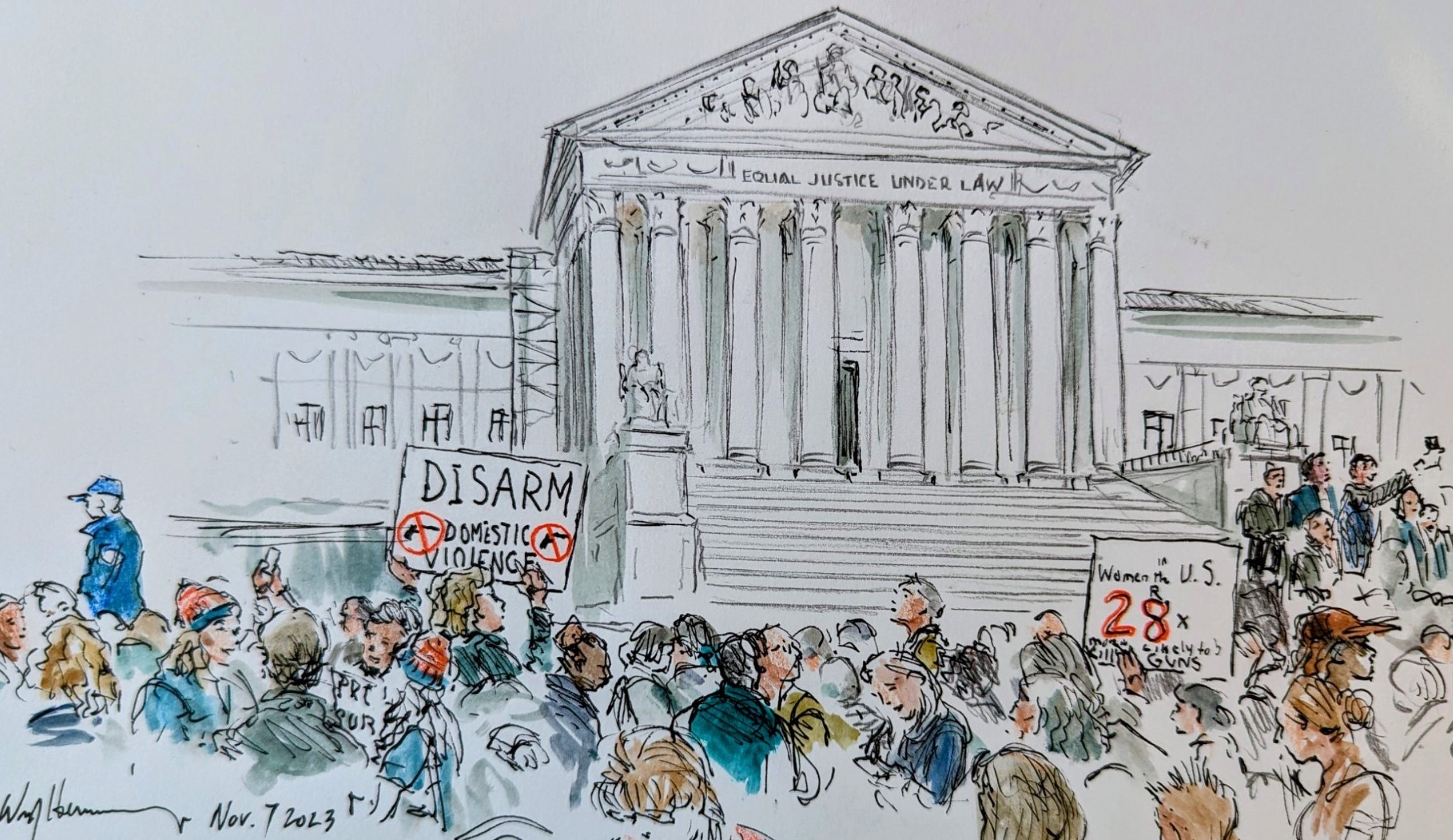Right to Bear Arms Restricted in Domestic Violence Case
 Don't mess with Texas, unless of course you are the SCOTUS. In United States v Rahimi, an 8-1 decision with Justice Clarence Thomas the sole dissenter, SCOTUS upheld a federal law restricting a person's right to possess a weapon when the subject of a domestic restraining order.
Don't mess with Texas, unless of course you are the SCOTUS. In United States v Rahimi, an 8-1 decision with Justice Clarence Thomas the sole dissenter, SCOTUS upheld a federal law restricting a person's right to possess a weapon when the subject of a domestic restraining order.
We have been tracking this case over the past year since SCOTUS granted certiorari on the last day of its term last June. The links to our previous posts are here and here.
Texan Zackey Rahimi came within the scope of the federal law, 18 USC 922(g)(8), when he assaulted his then girlfriend with whom he has a minor child. Rahimi was also a suspect in several shootings. When local law enforcement searched his home in conjunction to those alleged crimes, they found weapons, triggering the above-referenced federal gun inunction.
Rahimi challenged the constitutionality of the federal weapon injunction citing to the SCOTUS holding in New York Rifle and Pistol Assn v Bruen; the most recent and seminal second amendment case. The Bruen Court ruled that gun restrictions should only be upheld when there is a "tradition of such regulations" in our nation's history; a "well-established and representative analogue" to the challenged law.
As the SCOTUS drifts toward concluding its 2023/24 session, it released its nearly unanimous Rahimi decision on Friday, June 21, reversing the 5th Circuit's decision striking the federal gun restriction.
Muskets and Sabers
The federal circuit courts of appeal apparently have struggled to apply the Bruen standard of traditional regulations in our nation's history. Justice John Roberts authored the majority opinion addressing the 5th Circuit's misapplication of the Bruen standard, stating that the Court's line of 2nd amendment cases, "were not meant to suggest a law trapped in amber."
In agreeing with Mr. Rahimi, the 5th Circuit allowed that the Bruen standard did not require a "historical twin" to the at-issue regulation; but ultimately, the intermediate appellate court concluded that the government failed to demonstrate the "well-established and representative analogue" for the federal injunction to survive under the 2nd amendment.
In reversing the 5th Circuit, Justice Roberts instructed the lower courts not to such a restrictive view of Bruen's "historical tradition" requirement. Justice Roberts used the example of muskets and sabers, the only type of weapons in existence at the time the founding fathers authored the 2nd amendment. Nevertheless, Roberts observed, the 2nd amendment protects a wide range of modern weapons; not just the muskets and sabers of yesteryear.
When testing a modern weapon regulation, courts are now instructed to determine whether that regulation is "relevantly similar" to our nation's history of weapon regulations.
Personal Protection Orders and Injunctions
Perhaps the modern epidemic of mass shootings in America caused the Court to fashion this 2nd Amendment rule and loosen its Bruen test. Justice Roberts tied two traditional weapons regulations together [restricting weapons for those threatening violence to others by requiring a bond and by subjecting such persons to criminal liability] in concluding that the challenged federal law passed constitutional muster.
Justice Roberts concluded that domestic violence injunctions or personal protection orders are not identical to the historic regulatory schemes addressing persons threatening harm to others, but they were sufficiently similar. So the bottom line now is, state and federal legislatures can fashion regulations qualifying or restricting the possession of firearms for those that threaten others with violence, domestic or otherwise.
The SCOTUS majority opinion also noted that Mr. Rahimi challenged the federal gun regulation on its face, asserting it is always unconstitutional in every case and circumstance. Justice Roberts held that the 5th Circuit erred by not analyzing whether the challenged law was unconstitutional as applied to the specific circumstances of Rahimi. Roberts thought that the lower court should have examined scenarios, like the domestic violence scenario, where the challenged law was most likely to be deemed constitutional.
Lone Dissenter Wrote Bruen Opinion
Interestingly, Justice Thomas wrote the lone dissent in Rahimi and is also the author of the Court's earlier Bruen opinion, with its complicated and restrictive historical analogue test. Justice Thomas concluded that the government produced no evidence that the at-issue gun regulation “is consistent with the Nation’s historical tradition of firearm regulation."
Casting a blind eye to our modern mass shooting epidemic, not to mention the prevalence of domestic violence, Justice Thomas simply concludes that the majority's convenient reliance on antiquated laws requiring a person that makes threats to others to post a bond or submit to criminal charges for gun possession eligibility is misplaced. We here at Clarkston Legal find Justice Thomas' analysis harshly restrictive in the modern world of mass shootings; a world where domestic violence is all too common.
Under Justice Thomas' analysis in both Bruen and Rahimi, there can never be a constitutional modern weapon regulation because we live in a far different world today than the world of the late Eighteenth Century. According to Thomas, those differences alone doom any attempted governmental regulation of the apparently sacred and near absolute right to bear arms.
The majority wisely made accomodations for people like Rahimi; violent and under injunction for domestic violence. Such people, in our opinion, are not eligible to possess weapons. Put another way, people whose conduct put them under the injunction of a personal protection order have disqualified themselves from participating in the right to bear arms.
Effect on Michigan's New Extreme Risk Protection Order
Michigan's legislature passed a new form of protectiove injunction last year called the "extreme risk protection order". Under this law, someone being threatened by another person can file a petition asserting that the defendant poses a significant risk of harm to themself or to others by possessing a firearm. The new law allows law enforcement to execute a preemptive taking of the respondent's weapons.
The new law allows for an expedited procedure and calls for a court to address a complaint and issue an order within 24-hours. If a court determines that the allegations in a complaint pose a threat of immediate or irreparable injury, the court can proceed ex parte [without notice to Defendant].
Admittedly, this new law is a significant restriction on one's Second Amendment right to bear arms. We shall see whether legal challenges are lodged to the constitutionality of the law, especially in the wake of the Rahimi case.
We Can Help
If you are facing a petition under Michigan's new extreme risk protection law, or if you are a victim of domestic violence and need assistance, contact our law firm to schedule a free consultation. We have represented clients on both sides of the domestic violence equation.

